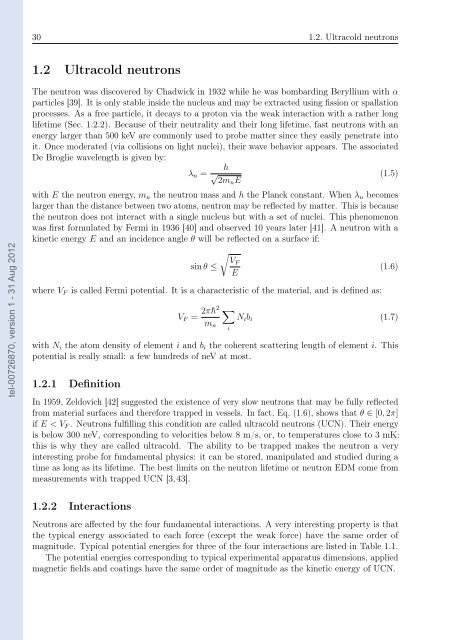Développement et optimisation d'un système de polarisation de ...
Développement et optimisation d'un système de polarisation de ...
Développement et optimisation d'un système de polarisation de ...
Create successful ePaper yourself
Turn your PDF publications into a flip-book with our unique Google optimized e-Paper software.
tel-00726870, version 1 - 31 Aug 2012<br />
30 1.2. Ultracold neutrons<br />
1.2 Ultracold neutrons<br />
The neutron was discovered by Chadwick in 1932 while he was bombarding Beryllium with α<br />
particles [39]. It is only stable insi<strong>de</strong> the nucleus and may be extracted using fission or spallation<br />
processes. As a free particle, it <strong>de</strong>cays to a proton via the weak interaction with a rather long<br />
lif<strong>et</strong>ime (Sec. 1.2.2). Because of their neutrality and their long lif<strong>et</strong>ime, fast neutrons with an<br />
energy larger than 500 keV are commonly used to probe matter since they easily pen<strong>et</strong>rate into<br />
it. Once mo<strong>de</strong>rated (via collisions on light nuclei), their wave behavior appears. The associated<br />
De Broglie wavelength is given by:<br />
λn =<br />
h<br />
√ 2mnE<br />
with E the neutron energy, mn the neutron mass and h the Planck constant. When λn becomes<br />
larger than the distance b<strong>et</strong>ween two atoms, neutron may be reflected by matter. This is because<br />
the neutron does not interact with a single nucleus but with a s<strong>et</strong> of nuclei. This phenomenon<br />
was first formulated by Fermi in 1936 [40] and observed 10 years later [41]. A neutron with a<br />
kin<strong>et</strong>ic energy E and an inci<strong>de</strong>nce angle θ will be reflected on a surface if:<br />
sin θ ≤<br />
VF<br />
E<br />
where VF is called Fermi potential. It is a characteristic of the material, and is <strong>de</strong>fined as:<br />
VF = 2π¯h2 <br />
mn<br />
with Ni the atom <strong>de</strong>nsity of element i and bi the coherent scattering length of element i. This<br />
potential is really small: a few hundreds of neV at most.<br />
1.2.1 Definition<br />
In 1959, Zeldovich [42] suggested the existence of very slow neutrons that may be fully reflected<br />
from material surfaces and therefore trapped in vessels. In fact, Eq. (1.6), shows that θ ∈ [0, 2π]<br />
if E < VF . Neutrons fulfilling this condition are called ultracold neutrons (UCN). Their energy<br />
is below 300 neV, corresponding to velocities below 8 m/s, or, to temperatures close to 3 mK:<br />
this is why they are called ultracold. The ability to be trapped makes the neutron a very<br />
interesting probe for fundamental physics: it can be stored, manipulated and studied during a<br />
time as long as its lif<strong>et</strong>ime. The best limits on the neutron lif<strong>et</strong>ime or neutron EDM come from<br />
measurements with trapped UCN [3, 43].<br />
1.2.2 Interactions<br />
Neutrons are affected by the four fundamental interactions. A very interesting property is that<br />
the typical energy associated to each force (except the weak force) have the same or<strong>de</strong>r of<br />
magnitu<strong>de</strong>. Typical potential energies for three of the four interactions are listed in Table 1.1.<br />
The potential energies corresponding to typical experimental apparatus dimensions, applied<br />
magn<strong>et</strong>ic fields and coatings have the same or<strong>de</strong>r of magnitu<strong>de</strong> as the kin<strong>et</strong>ic energy of UCN.<br />
i<br />
Nibi<br />
(1.5)<br />
(1.6)<br />
(1.7)

















